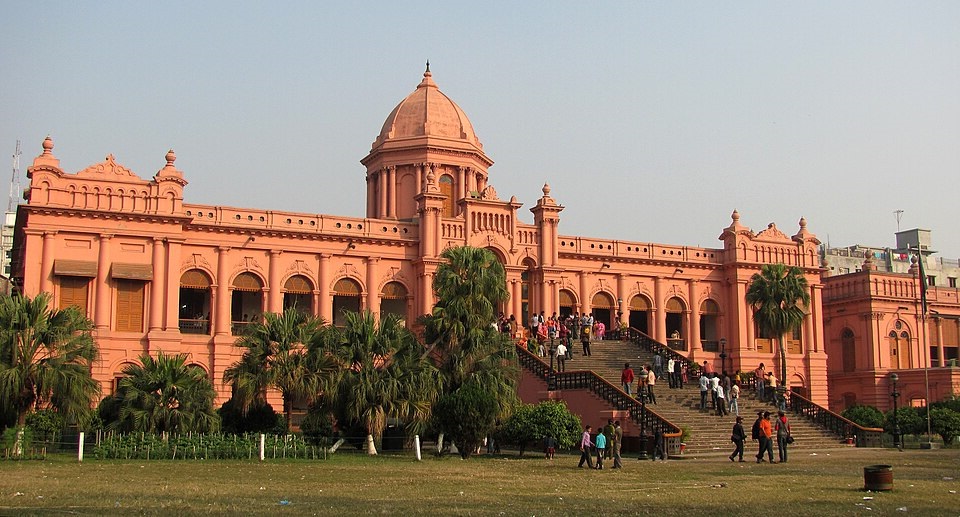Ahsan Manzil
In the heart of Dhaka, Bangladesh, stands one of the city’s most iconic landmarks: Ahsan Manzil. Known as the Pink Palace, this majestic building reflects the grandeur of Dhaka’s history and the legacy of the Nawabs of Dhaka. Once the official residence of the Nawab family, Ahsan Manzil has now been transformed into a museum, preserving the culture, art, and history of Bengal’s aristocratic past. Today, it is one of the most visited tourist attractions in Bangladesh and a proud symbol of Dhaka’s architectural heritage.
Historical Background of Ahsan Manzil
The origins of Ahsan Manzil date back to the 19th century, when the French established a trading house on the site. Later, it was purchased by Khwaja Alimullah, a wealthy zamindar, who began transforming it into a magnificent palace. The construction was completed in 1872 by his son, Nawab Khwaja Abdul Ghani, who named it after his son, Khwaja Ahsanullah.
The palace soon became the residence and administrative center of the Nawab family. It played a key role in social and political gatherings, hosting important dignitaries and witnessing significant decisions in Bengal’s history.
Architectural Design of the Pink Palace
Ahsan Manzil is a stunning example of Indo-Saracenic Revival architecture, blending Mughal, European, and Bengali styles.
Key Features:
-
Exterior – The building is painted in a distinct pink hue, giving it the nickname Pink Palace. Its two-story structure is adorned with classical columns, arches, and domes.
-
Central Dome – The palace features a large central dome, a striking element that adds grandeur to its design.
-
Staircases – Majestic marble staircases lead to the main entrance, giving visitors a sense of aristocratic charm.
-
Interior Layout – With 31 rooms, 23 galleries, and high ceilings, the palace showcases chandeliers, antique furniture, and royal décor.
-
Surroundings – Overlooking the Buriganga River, the palace once had lush gardens and open courtyards, offering a royal lifestyle to its residents.
Role in Bengal’s Political and Cultural History
During the British colonial period, Ahsan Manzil was more than just a residence—it was a center of influence and decision-making. The Nawabs of Dhaka hosted meetings with politicians, business leaders, and foreign guests, shaping the cultural and political landscape of Bengal.
The palace became a hub for aristocratic celebrations, musical events, and cultural exchanges. It symbolized the power and prestige of the Nawab family, who played a vital role in Dhaka’s development during the 19th and early 20th centuries.
Transformation into a Museum
By the mid-20th century, Ahsan Manzil fell into neglect after the decline of the Nawab family. However, recognizing its cultural value, the Government of Bangladesh took initiatives to preserve it.
In 1985, the palace was restored and converted into a museum under the supervision of the Bangladesh National Museum. Today, it houses over 4,000 artifacts, including portraits, furniture, household items, weapons, and historical documents from the Nawab era.
What Visitors Can See Inside Ahsan Manzil
A tour of Ahsan Manzil is like stepping back into the aristocratic lifestyle of the Nawabs.
Highlights for Visitors:
-
Royal Courtrooms – Rooms used for official gatherings, decorated with chandeliers and ornate furniture.
-
Living Quarters – Bedrooms and dining halls showcasing the luxurious lifestyle of the family.
-
Exhibits – Items such as coins, glassware, porcelain, and weapons from the 19th century.
-
Portrait Galleries – Paintings and photographs of the Nawab family and notable historical figures.
-
Cultural Artifacts – Displays of local craftsmanship and items reflecting Bengal’s rich heritage.
Ahsan Manzil as a Tourist Attraction
Today, Ahsan Manzil is one of the most popular tourist destinations in Dhaka. Both local and international visitors are drawn to its rich history and architectural beauty.
Visitor Information:
-
Location – Situated in Kumartoli, on the banks of the Buriganga River in Old Dhaka.
-
Opening Hours – Typically open 10:30 AM to 5:30 PM (closed on Thursdays), though timings may vary.
-
Entry Fees – Affordable entry for locals and tourists, with guided tours available.
-
Best Time to Visit – Winter months (November to February) provide pleasant weather for exploring Old Dhaka.
Significance of Ahsan Manzil in Dhaka’s Identity
Ahsan Manzil is not just a building—it is a symbol of Dhaka’s historical evolution. The palace represents the rise of the city as a center of culture, politics, and trade during the colonial period. Its preservation as a museum ensures that future generations can appreciate the grandeur of Bengal’s aristocratic past.
For the people of Bangladesh, the Pink Palace is a reminder of both pride and responsibility—to safeguard national heritage and celebrate the country’s cultural richness.
Challenges and Preservation Efforts
Like many historical monuments, Ahsan Manzil faces challenges such as environmental damage, river pollution, and urban encroachment. The government and cultural organizations continue to invest in restoration projects to maintain its structure and protect its artifacts. Awareness campaigns also encourage visitors to respect the site and contribute to heritage conservation.
Conclusion: The Timeless Legacy of Ahsan Manzil
Ahsan Manzil, the Pink Palace of Dhaka, is much more than a tourist attraction—it is a living museum of Bengal’s history. From its days as the royal residence of the Nawabs to its modern role as a cultural museum, the palace embodies the city’s journey through time.
For travelers, a visit to Ahsan Manzil offers not only a glimpse into the lavish lifestyle of the past but also a deeper understanding of Dhaka’s cultural roots. Its pink façade continues to shine as a beacon of heritage, inviting people to celebrate the rich history of Bangladesh.
Whether you are a history enthusiast, architecture lover, or curious traveler, Ahsan Manzil stands as a must-visit landmark in Dhaka, echoing the grandeur of Bengal’s past and inspiring pride for future generations.


You must be logged in to post a comment.